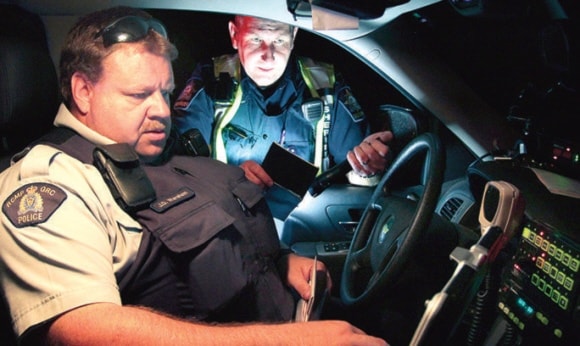More than five people died in Alberta over the course of the May long weekend.
Despite their best efforts to keep people safe, the Ponoka Integrated Traffic Unit (PITU) and emergency crews responded to a rollover near Menaik Road on Highway 2 May 18. One occupant was thrown from the vehicle and as a result died.
Officers in the traffic unit don’t just write tickets, they also try to educate motorists on safe driving behaviours. Ponoka News was invited for a ride along with Sheriff John Walker on Friday of the long weekend to provide insight into the job officers face.
During the 10-hour-shift, Walker stopped a car travelling at almost 157 km/h and it was not uncommon to see vehicles cruising along at a more than 130 km/h. His focus is on those drivers who were blatantly breaking those boundaries and creating unsafe roads.
“It’s not just about tickets, it’s about education and safety,” stated Walker. “I could write a hundred tickets if I wanted to but I want to catch dangerous drivers.”
A ticket can be a useful reminder to drivers to be safe on the highways, he added.
He does have a partner, Const. Doug Wareham who handles the RCMP side of the highway patrol, but Wareham is in another vehicle. Sometimes when officers have a seatbelt or cellphone operation there is some advantage to having a partner in the cruiser, this allows the driver to focus on the road while the passenger can monitor drivers’ behaviours.
“I love the job…I think sometimes the biggest challenge is just there’s never enough resources,” Walker said of being an Alberta Sheriff.
Having two units on Highway 2 — who have to cover an area from north of Highway 11A to south of the Millett Secondary Highway 616 overpass — can be stressful if they have to take calls on either end of their area. This does not happen all the time, there are days when drivers generally follow the rules of the road but there are also days when there is not much chance of a break.
“I usually try to run my territory at least once from end to end,” he added of the approximate 100 kilometres of road.
Sheriffs are trained to estimate a driver’s speed visually without equipment as well and he uses visual cues to help. “The radar and the laser confirms my observations.”
Walker has to be able to use equipment in court and he needs to prove the speed was actually what he estimated.
Officers received calls throughout the shift from concerned drivers usually if a car was being driven in erratically but one issue involved a white minivan being driven southbound at 93 km/h in the fast lane.
Extreme speeds are not the only danger to motorists; a motorist driving at such a low rate of speed can cause congestion on the road and is also dangerous. “It’s a huge hazard out here and he was going slow.”
There appears to be an ebb and flow to the flow of traffic and Walker would follow that flow to better enforce traffic laws.
The sheriffs’ mandate is traffic enforcement and they cannot pursue drivers who attempt to evade officers but they do pass on information to RCMP units further along the road.
“Every check stop we’re trying to balance enforcement, education and public relations,” said Walker.
